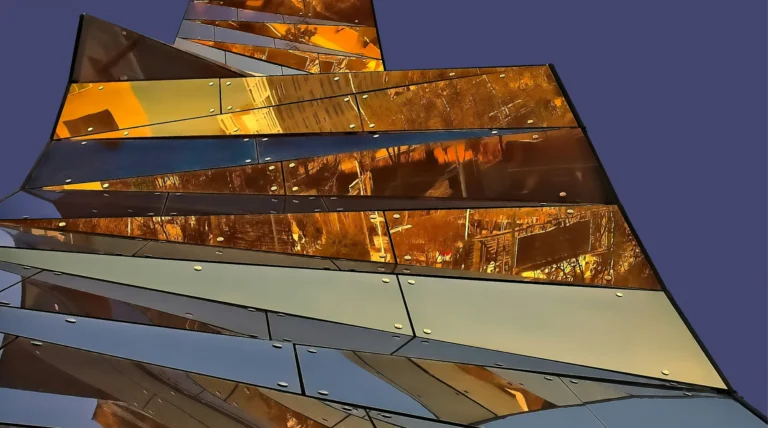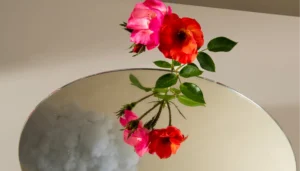Mirror product photography is used in e-commerce and advertising to present products by capturing their reflections in mirrors. This technique effectively captures different angles, details, and features of a product in a single shot.
In combination with computer-generated images, it has revolutionized the presentation of products in e-commerce and advertising.
This innovative approach solves the traditional challenges associated with mirroring and offers numerous benefits, making it a powerful tool for presenting products. Read on to discover how CGI can benefit you and your brand.
Traditional challenges in achieving reflections

Achieving realistic reflections involves several challenges. However, the most common ones involve unwanted reflections, limited angles, and restrictive space.
Advancements in rendering technology, on the other hand, have helped address these challenges, making it easier for artists to create breathtaking images.
- Unwanted Reflections – Traditional photography setups with physical mirrors often struggle to control unwanted reflections. External elements, such as the photographer’s equipment, studio lighting, or surroundings, might inadvertently appear in the reflection, distracting viewers from the primary focus – the product. CGI, however, allows you to meticulously control every aspect of the virtual environment, including reflections. This ensures that only the desired elements are present in the reflection, resulting in a clean and distraction-free final image that enhances the overall aesthetic appeal of the product.
- Limited Angles – Traditional mirror product photography often restricts the angles at which a product can be captured. This limitation can be especially problematic when you try to showcase products with intricate details from multiple perspectives. One of the remarkable advantages of a 3D model is its flexibility. Virtual cameras and light sources can be positioned from any angle, providing the freedom to capture dynamic shots that showcase various facets of the product. This flexibility significantly enhances the visual storytelling potential of mirror product photography.
- Space and setup – Traditional mirror product photography setups demand physical space and careful planning. Achieving the right lighting conditions and minimizing undesired reflections can be a time-consuming and complex process, especially in constrained studio environments.
Digital images eliminate the need for physical mirrors and extensive setups. The virtual environment can be created, modified, and fine-tuned with ease, offering a more efficient workflow. This saves you physical space and contributes to a streamlined production process, enabling quicker turnaround times.
CGI technology in mirror product photography

As we described before, mirrors are challenging to capture in photos because of their reflective nature. However, you can overcome them if you employ the help of professionals. For example, we provide a free trial for our customers, so they can learn how we approach our projects and what their products can look like through CGI magic. Take a look at our portfolio to see just a few examples.
On the other hand, you can overcome the challenges on your own, if you wish to do so, by using advanced rendering techniques, as computer-generated images come with benefits that can help you achieve beautiful and artistic results.
Here are the most notable advantages CGI can offer you and your brand.
Flexibility
CGI stands out for its unparalleled flexibility in positioning and manipulating virtual elements. Reflections can be crafted to suit the specific needs of your product or campaign, allowing creative and eye-catching presentations that captivate the audience. This helps you stand out in the competitive landscape of e-commerce and advertising, making your brand memorable in your audience’s mind.
Cost-effectiveness
The cost associated with traditional mirror product photography setups, including physical mirrors, professional lighting, and studio space, can be substantial. CGI reduces these expenses significantly by eliminating the need for physical props and allowing for the reuse of virtual assets across different projects. This is especially valuable for brands or projects with budget constraints, allowing you to allocate resources more efficiently.
For example, we have to create a 3D replica of your product only once. After this, each time you collaborate with us, we can skip this step and go right into creating your image.
Consistent quality
CGI ensures consistent image quality by removing variables associated with traditional photography, such as changing lighting conditions. The result is a polished and professional look that remains uniform across all product images, contributing to a cohesive brand image.
Moreover, you can use this to create a unique and personalized online catalog with your products. By doing so, you showcase more items while retaining the same image style.
Customizability
Brands can leverage CGI to customize reflections based on their unique requirements. This level of control allows brands to create a unique visual identity, ensuring that the reflections align seamlessly with their overall branding strategy.
Adaptability to trends
CGI offers you the ability to adapt quickly to design trends and consumer preferences. Whether it’s the sleek lines of the latest smartphone or the organic aesthetic favored in beauty products, CGI reflections can be adjusted to match the moment.
In summary, CGI technology has transformed mirror product photography by addressing traditional challenges and offering a range of benefits.
Examples of successful implementations

Computer-generated imagery has transformed the world of product photography. Its potential for creating visually striking and incredibly realistic images is practically limitless. The following industries are examples of how digital images have contributed to their success.
Automotive industry
CGI is widely used in the automotive industry to showcase vehicles in various settings. Car manufacturers leverage CGI to create reflections that highlight the sleek design and features of their vehicles, providing a virtual showroom experience.
Furniture and home decor
Computer-generated images allow you to create virtual rooms where furniture reflects seamlessly in mirrors or reflective surfaces. Virtual rooms are similar to real-life showrooms, the difference lies in their applicability. This application enables customers to visualize how products will fit into their living spaces with realistic and compelling imagery. Therefore, the customers can recreate their room digitally and integrate the new furniture before buying it.
Jewelry and fashion
The jewelry and fashion industries have embraced CGI for its ability to capture the smallest details of intricate pieces. Customizable reflections enhance the visual appeal of jewelry, allowing brands to showcase their products in a way that aligns with their unique style and branding, often exceeding the expectations of modern consumers.
Technology and gadgets
In the fast-paced world of technology and gadgets, where sleek design and intricate details matter, digital images play a crucial role in elevating product presentations. Companies manufacturing smartphones, laptops, and other electronic devices have increasingly turned to this for mirror product photography to showcase their products in a futuristic and dynamic manner.
Cosmetics and beauty products
The cosmetics and beauty industry relies heavily on visual appeal to attract consumers. Therefore, digital assets have become a game-changer in presenting beauty products, providing stunning and hyper-realistic mirror reflections that emphasize the elegance and allure of the items.
Reflections in the cosmetics industry go beyond mere mirroring. They are crafted to enhance the elegance of products like perfumes, makeup compacts, and skincare items, creating an atmosphere of sophistication.
Therefore, computer-generated images offer the opportunity to turn reflections into art. Mirrors can be strategically positioned to create visually captivating patterns and designs, adding an artistic flair to the presentation of beauty products.
In conclusion, the successful implementations of CGI in mirror product photography extend beyond one industry. These applications enhance the product presentation and contribute to a more immersive and engaging online shopping experience, shaping the future of e-commerce and advertising.
How to photograph a mirror with CGI

Photographing a mirror with CGI involves several steps to create a realistic and convincing final image.
Firstly, start by designing and modeling the mirror in a software program, ensuring accurate proportions and details to mimic a real object. Next, apply textures to the mirror surface to simulate its reflective properties and add any specific patterns that make it look authentic.
Lighting is a critical aspect in creating a convincing mirror image, so set up virtual lights in the environment that bounce off the mirror accurately to create reflections. Adjust the intensity, color, and angles of the lights to achieve the desired reflection effect and to make the mirror appear more natural.
It’s important to use ray-trancing techniques to calculate how light rays interact with the mirror surface, producing accurate reflections of the virtual scene. Experiment with different camera angles and perspectives to find the best composition that showcases the mirror while capturing interesting reflections and light interplay.
Consider adding additional objects or elements around the mirror to enhance the visual appeal of the scene and create a more dynamic composition. Fine-tune the rendering settings to ensure a high-quality output that emphasizes the mirror’s reflective properties and overall realism.
Lastly, optimize the final image by refining details, adjusting colors and contrast, and potentially adding post-processing effects to enhance the overall visual impact of the CGI mirror photograph.
By paying close attention to detail and following these steps, you can create stunning and lifelike mirror images using CGI techniques.
Wrapping up
CGI technology has transformed the way products are presented in e-commerce and advertising. By addressing traditional challenges such as unwanted reflections and limited angles, computer-generated images offer unparalleled flexibility, cost-effectiveness, and customizability. Brands can create visually stunning product imagery, enhancing the online shopping experience for customers.
FAQ
Why should I consider using CGI for mirror product photography?
CGI allows precise control over reflections, lighting, and angles, resulting in highly realistic and customizable images that enhance the appeal of your products.
Is it cost-effective?
While digital images may have a higher upfront cost compared to traditional photography, their versatility and quality can lead to long-term savings and increased sales.
Can CGI be used for all types of products?
Yes, it can be utilized for a wide range of products, including jewelry, furniture, cosmetics, and apparel, providing a seamless and visually engaging representation.
How long does it take to create product images through CGI?
The time required to create CGI images can vary depending on the complexity of the project, but generally, it can take a few days to a few weeks to produce high-quality renderings.
How can I incorporate such product photography into my marketing strategy?
By showcasing professional images on your website, social media platforms, and marketing materials, you can enhance the visual appeal of your products, attract more customers, and increase sales opportunities.



